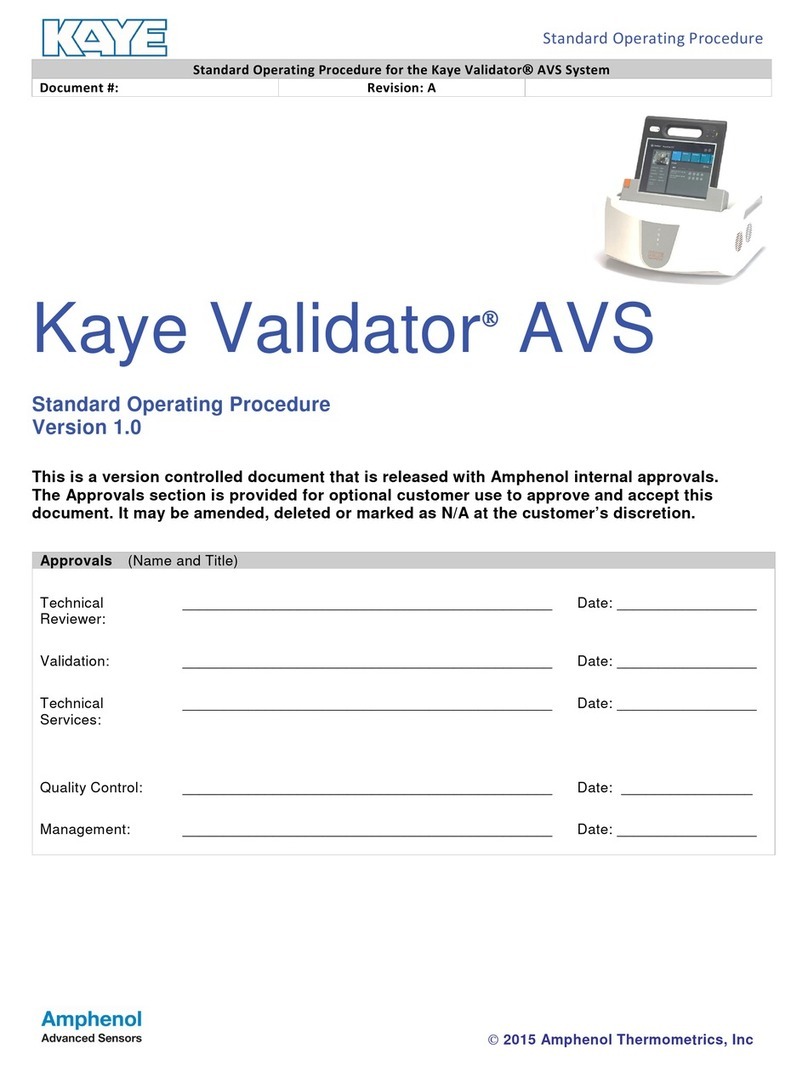
LIMITED WARRANTY AND LIMITATION OF LIABILITY
Each KAYE product is warranted to be free from defects in material and workmanship under normal use and
service. The warranty period is one year and begins on the date of shipment. Parts, product repairs, and
services are warranted for 90 days. This warranty extends only to the original buyer or end-user customer of
a KAYE authorized reseller, and does not apply to fuses, disposable batteries, or to any product which, in
KAYE’S opinion, has been misused, altered, neglected, contaminated, or damaged by accident or abnormal
conditions of operation or handling. KAYE warrants that software will operate substantially in accordance
with its functional specifications for 90 days and that it has been properly recorded on non-defective media.
KAYE does not warrant that software will be error free or operate without interruption.
KAYE authorized resellers shall extend this warranty on new and unused products to end-user customers
only but have no authority to extend a greater or different warranty on behalf of KAYE. Warranty support is
available only if product is purchased through a KAYE authorized sales outlet or Buyer has paid the
applicable international price. KAYE reserves the right to invoice Buyer for importation costs of
repair/replacement parts when product purchased in one country is submitted for repair in another country.
KAYE warranty obligation is limited, at KAYE's option, to refund of the purchase price, free of charge repair,
or replacement of a defective product which is returned to a KAYE authorized service center within the
warranty period.
To obtain warranty service, contact your nearest KAYE authorized service center to obtain return
authorization information, then send the product to that service center, with a description of the difficulty,
postage and insurance prepaid (FOB Destination). KAYE assumes no risk for damage in transit. Following
warranty repair, the product will be returned to Buyer, transportation prepaid (FOB Destination). If KAYE
determines that failure was caused by neglect, misuse, contamination, alteration, accident, or abnormal
condition of operation or handling, including overvoltage failures caused by use outside the product’s
specified rating, or normal wear and tear of mechanical components, KAYE will provide an estimate of repair
costs and obtain authorization before commencing the work. Following repair, the product will be returned to
the Buyer transportation prepaid and the Buyer will be billed for the repair and return transportation charges
(FOB Shipping Point).
THIS WARRANTY IS BUYER'S SOLE AND EXCLUSIVE REMEDY AND IS IN LIEU OF ALL OTHER
WARRANTIES, EXPRESS OR IMPLIED, INCLUDING BUT NOT LIMITED TO ANY IMPLIED WARRANTY
OF MERCHANTABILITY OR FITNESS FOR A PARTICULAR PURPOSE. KAYE SHALL NOT BE LIABLE
FOR ANY SPECIAL, INDIRECT, INCIDENTAL, OR CONSEQUENTIAL DAMAGES OR LOSSES,
INCLUDING LOSS OF DATA, ARISING FROM ANY CAUSE OR THEORY.
Since some countries or states do not allow limitation of the term of an implied warranty, or exclusion or
limitation of incidental or consequential damages, the limitations and exclusions of this warranty may not
apply to every buyer. If any provision of this Warranty is held invalid or unenforceable by a court or other
decision-maker of competent jurisdiction, such holding will not affect the validity or enforceability of any other
provision.
Asia, and Middle East
Amphenol Advanced Sensors Germany GmbH
Sinsheimer Strasse 6
D-75179 Pforzheim
T +49 (0) 7231-14 335 0
F +49 (0) 7231-14335 29
kaye@amphenol-sensors.com
www.kayeinstruments.com
U.S.A., and Europe
Kaye Thermometrics, Inc.
967 Windfall Road
St. Marys, PA 15857
Tel: +1(814) 834-9140
Fax: +(814) 781-7969
kaye-us@amphenol-sensors.com
www.ka
einstruments.com
India:
Amphenol Interconnect India Pvt Ltd.
Plot no. 6, Survey No.64
Software Units layout
MAHAVEER TECHNO PARK
Hitech City, Madhapur
Hyderabad, Telangana – 500081
T: +91 40 33147100
China:
Sales and Service
Amphenol (Changzhou) Connector Systems
305 Room 5D
Jintong Industrial Park
Wujin, Changzhou, Jiangsu, China
T: +86 519 8831 8080 x 50087
F: +86 519 8831 2601




























